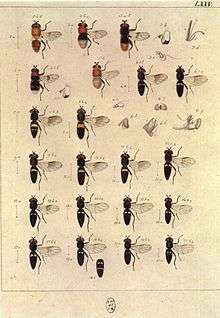Pipiza noctiluca
Pipiza noctiluca is a species of Hoverfly, from the family Syrphidae, in the order Diptera.[2]
| Pipiza noctiluca | |
|---|---|
 | |
| Pipiza noctiluca in Europäischen Zweiflügeligen (figure 6) | |
| Scientific classification | |
| Kingdom: | |
| Phylum: | |
| Class: | |
| Order: | |
| Family: | |
| Subfamily: | |
| Tribe: | |
| Genus: | |
| Species: | P. noctiluca |
| Binomial name | |
| Pipiza noctiluca | |
| Synonyms[1] | |
| |
Description
External images
For terms see Morphology of Diptera
Wing length 6.5 -8mm. Tarsae1: segments 1-2 yellowish; face broadened towards mouth edge with eye margins divergent. Wing: dark cloud at median.3rd segment as long as wide. Abdomen yellow spots with small or abdomen entirely grey black.
See references for determination.[3][4][5][6]
Distribution
Palearctic Atlantic zone of Europe and Scandinavia. All Europe if older records are accepted[7][8]
Biology
Habitat: Salix stands and Quercus woodland, Atlantic scrub, conifer forest, conifer plantations. Suburban gardens and along hedges in farmland.[9] Flowers visited include umbellifers, Crataegus, Filipendula, Ranunculus, Rosa, Stellaria, Taraxacum.[10] Flies May to September. Pipiza larvae are predators of gall forming aphids.
References
- Chandler, Peter J. (1998). Checklists of Insects of the British Isles (New Series) Part 1: Diptera. Handbooks for the Identification of British Insects. New Series. 12. London: Royal Entomological Society of London. pp. 1–234. ISBN 0-901546-82-8.
- Van Veen, M.P. (2004). Hoverflies of Northwest Europe, Identification Keys to the Syrphidae (Hardback). Utrecht: KNNV Publishing. p. 254. ISBN 90-5011-199-8.
- Van Veen, M. (2004) Hoverflies of Northwest Europe: identification keys to the Syrphidae. 256pp. KNNV Publishing, Utrecht.addendum
- Van der Goot,V.S. (1981) De zweefvliegen van Noordwest - Europa en Europees Rusland, in het bijzonder van de Benelux. KNNV, Uitgave no.32: 275pp. Amsterdam.
- Bei-Bienko, G.Y. & Steyskal, G.C. (1988) Keys to the Insects of the European Part of the USSR, Volume V: Diptera and Siphonaptera, Part I. Amerind Publishing Co., New Delhi. ISBN 81-205-0080-6.
- Coe, R.L. (1953) Diptera: Syrphidae. Handbks.ident.Br.insects, 10(1): 1-98. R.ent.Soc.London. pdf
- Fauna Europaea
- Peck, L.V. (1988) Syrphidae. In: Soos, A. & Papp, L. (eds.) Catalogue of Palaearctic Diptera, 8: 11-230. Akad.Kiado, Budapest.
- Speight, M.C.D. (2011). "Species accounts of European Syrphidae (Diptera)" (PDF). Syrph the Net, the database of European Syrphidae. 65: 285pp.
- de Buck, N. (1990) Bloembezoek en bestuivingsecologie van Zweefvliegen (Diptera, Syrphidae) in het bijzonder voor België. Doc.Trav. IRSNB, no.60, 1-167.